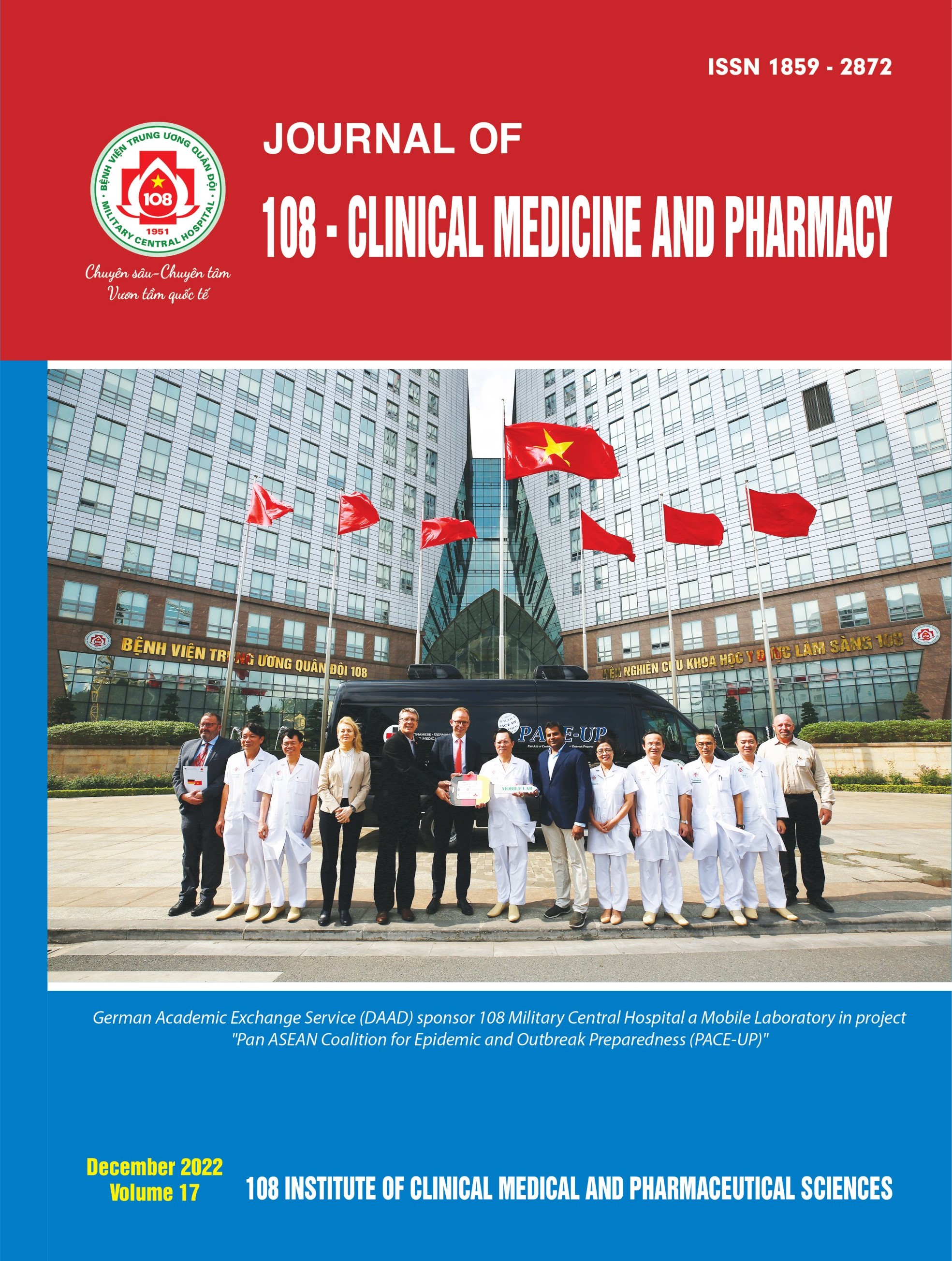Evaluation of the left ventricular torsion and twist in patients with chronic heart failure using three dimensional speckle tracking echocardiography
Main Article Content
Tóm tắt
Objective: To evaluate the left ventricular torsion deformation in patients with chronic heart failure using 3D speckle tracking echocardiography. Subject and method: From January 2018 to October 2020, a prospective, cross-sectional study with controls was conducted on 110 chronic heart failure patients and 50 healthy people who were treated as inpatients at the Department of Cardiology, 108 Military Central Hospital. Result: The mean age of the group of patients with heart failure was 65.82 ± 11.77, with men accounting for 66.36%, while the mean age of the control group was 65.16 ± 10.24, with men accounting for 68%. The heart failure group's left ventricular torsion parameters were all lower than the control group's: Peak-AR (4.56 ± 2.960 versus 10.41 ± 3.060; p<0.001), Peak-BR (-4.04 ± 2,250 vs -8.97 ± 2.750; p<0.001), Peak-Twist (7.94 ± 4.280 vs 18.99 ± 4.280; p<0.001), and Torsion (1.01 ± 0.560 vs 2.42 ± 0.600; p<0.001) and decreased in both the preserved EF group and the control group: Peak-AR (6.63 ± 2.49 vs 10.41 ± 3.06, p<0.05), Peak-BR (-5.02 ± 3,040 vs -8.97 ± 2.750; p<0.05), Peak-Twist (10.96 ± 4,740 vs 18.99 ± 4,280, p<0.05), Torsion (1.46 ± 0.600 vs 2.42 ± 0.600, p<0.05). The absolute value of left ventricular torsion parameters gradually decreased from heart failure with EF 50% to heart failure with a slight decrease in ejection fraction to heart failure with EF 40%. From the group of heart failure with grade I diastolic dysfunction to the group of heart failure with grade III diastolic dysfunction, the absolute value of the parameters of left ventricular torsion decreased statistically significantly. Apical rotation and left ventricular torsion have a moderate relationship with EF, left ventricular longitudinal strain as measured by 2D speckle tracking echocardiography. On 2D speckle tracking echocardiography, the angle of rotation should be weakly correlated with EF and left ventricular longitudinal strain drived from 2D speckle tracking echocardiography (2D–GLPS). Conclusion: Torsional deformation parameters of the left ventricle were lower in heart failure patients compared to controls, and they changed earlier in the group with preserved ejection fraction. Torsion deformation parameters, despite being the last variable parameter, are still quite sensitive in detecting left ventricular dysfunction.
Article Details
Các tài liệu tham khảo
2. Go AS, Mozaffarian D, Roger VL et al (2014) Heart disease and stroke statistics 2014 update: A report from the American Heart Association. Circulation 129(3): 28-292.
3. Solomon SD, Anavekar N, Skali H et al (2005) Candesartan in Heart Failure Reduction in Mortality I. Influence of ejection fraction on cardiovascular outcomes in a broad spectrum of heart failure patients. Circulation 112: 3738-3744.
4. Muraru D, Niero A, Rodriguez-Zanella H, Cherata D, Badano L (2018) Three-dimensional speckle-tracking echocardiography: Benefits and limitations of integrating myocardial mechanics with three-dimensional imaging. Cardiovasc Diagn Ther 8(1): 101-117. doi: 10.21037/cdt.2017.06.01.
5. Ponikowski P, Voors AA, Anker SD et al (2016) 2016 ESC Guidelines for the diagnosis and treatment of acute and chronic heart failure: The Task Force for the diagnosis and treatment of acute and chronic heart failure of the European Society of Cardiology (ESC)Developed with the special contribution of the Heart Failure Association (HFA) of the ESC. Eur Heart J 37(27): 2129-2200. doi: 10.1093/eurheartj/ehw128.
6. Greenbaum RA, Ho SY, Gibson DG, Becker AE, Anderson RH (1981) Left ventricular fibre architecture in man. Heart 45(3): 248-263.
7. Van Dalen BM, Geleijnse ML (2013) Left ventricular twist in cardiomyopathy. Cardiomyopathies IntechOpen London.
8. Nakatani S (2011) Left ventricular rotation and twist: why should we learn?. J Cardiovasc Ultrasound 19(1): 1-6. doi: 10.4250/jcu.2011.19.1.1.
9. Altman M, Bergerot C, Aussoleil A et al (2014) Assessment of left ventricular systolic function by deformation imaging derived from speckle tracking: A comparison between 2D and 3D echo modalities. European Heart Journal–Cardiovascular Imaging 15(3): 316-323.
10. Yip GW, Zhang Q, Xie JM et al (2011) Resting global and regional left ventricular contractility in patients with heart failure and normal ejection fraction: Insights from speckle-tracking echocardiography. Heart 97(4): 287-294.
11. Wang J, Khoury DS, Yue Y et al (2008) Preserved left ventricular twist and circumferential deformation, but depressed longitudinal and radial deformation in patients with diastolic heart failure. European heart journal 29(10): 1283-1289.
12. Sengupta PP, Narula J (2008) Reclassifying heart failure: Predominantly subendocardial, subepicardial, and transmural. Heart failure clinics 4(3): 379-382.
13. Maharaj N, Khandheria BK, Libhaber E et al (2014) Relationship between left ventricular twist and circulating biomarkers of collagen turnover in hypertensive patients with heart failure. Journal of the American Society of Echocardiography 27(10): 1064-1071.
 ISSN: 1859 - 2872
ISSN: 1859 - 2872
